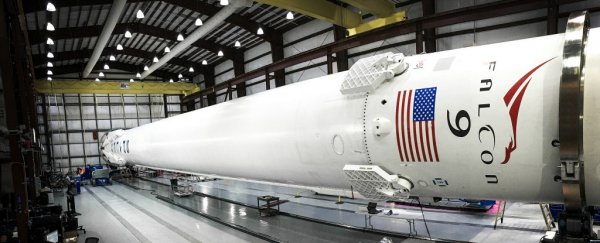SpaceX is scheduled to launch its most powerful rocket yet this Saturday between 8pm and 9pm ET. During SpaceX's last launch in June, a faulty rig, called a strut, broke in mid-launch, which caused one of the fuel tanks to burst, setting off a chain reaction that destroyed the rocket and its unmanned Dragon spacecraft. Since then, SpaceX has made some major and exciting upgrades to its rockets.
The aerospace company, founded and run by billionaire entrepreneur Elon Musk, will be flying its upgraded Falcon 9 for the first time this weekend. It will also be the first SpaceX launch since June.
In anticipation of the launch, SpaceX engineers made a few changes to the rocket. The main change was upgrading the rocket's first stage, or booster. That's the tallest part of the rocket, located at the bottom, that gets the spacecraft from the ground into space. The larger rocket booster, which stands about five feet taller, provides:
- More space to carry extra fuel
- Increased power and faster rocket speeds
The new-and-improved Falcon 9 is now 70 metres (229.6 feet) tall and can produce up to 1.7 million pounds (771,000 kg) of thrust - a unit of measurement for rocket power. That's about 200,000 pounds (90,700 kg) more thrust than earlier SpaceX rockets - or a little more power than what one of SpaceX's Merlin rocket engines produce.
The Falcon 9 booster runs on nine of these Merlin engines, so it's like the company is getting an extra engine's worth of power out of this new upgrade.
These upgrades certainly get Musk's seal of approval: "I think it's a significantly improved rocket from the last one," Musk said during a December 15 talk at the American Geophysical Union's Fall Meeting, according to SpaceNews.
Another exciting result of these upgrades is that SpaceX can now attempt to retrieve its rocket boosters after most of its missions to space. That means more landing attempts and an overall higher probability of success, though the company has yet to announce if there will be a rocket landing this Saturday, or not.
This year, SpaceX has tried twice to retrieve its rocket boosters by guiding them back to Earth using GPS tracking, and then slowing them down to a gentle stop onto a drone ship in the Atlantic.
Both tries ended in explosion, but SpaceX says it has pinpointed what went wrong each time and fixed the problem to prevent the same issue from happening again. And it will keep tweaking and tuning until it succeeds.
Before, the aerospace company could only try its epic rocket landings on missions to the International Space Station because the ISS orbits Earth at relatively low altitudes compared to commercial satellites. So, if SpaceX was launching satellites into orbit, that mission would exhaust all of its booster's fuel, leaving none left for a return flight. But now, that's no longer the case.
On Saturday, SpaceX will ferry 11 satellites into orbit for the telecommunications company Orbcomm Inc. And thanks to the latest upgrades, the Falcon 9 booster will have enough fuel after life off to attempt a landing.
But whether SpaceX will actually attempt a rocket landing or not is not clear. So far, the company has been uncharacteristically quiet regarding this weekend's upcoming launch. Stay tuned for updates about whether or not SpaceX will try another rocket landing.
This article was originally published by Business Insider.
More from Business Insider:
